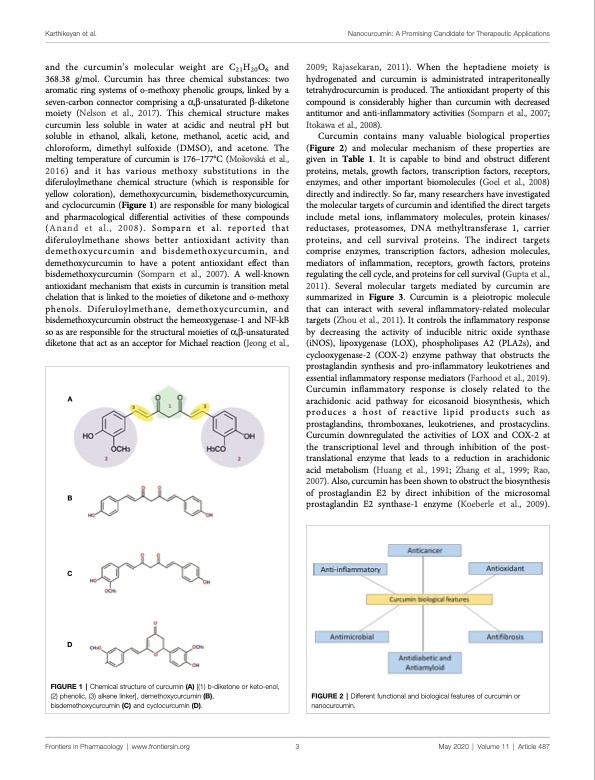
PDF Publication Title:
Text from PDF Page: 003
Karthikeyan et al. Nanocurcumin: A Promising Candidate for Therapeutic Applications and the curcumin’s molecular weight are C21H20O6 and 368.38 g/mol. Curcumin has three chemical substances: two aromatic ring systems of o-methoxy phenolic groups, linked by a seven-carbon connector comprising a a,b-unsaturated b-diketone moiety (Nelson et al., 2017). This chemical structure makes curcumin less soluble in water at acidic and neutral pH but soluble in ethanol, alkali, ketone, methanol, acetic acid, and chloroform, dimethyl sulfoxide (DMSO), and acetone. The melting temperature of curcumin is 176–177°C (Mosǒ vská et al., 2016) and it has various methoxy substitutions in the diferuloylmethane chemical structure (which is responsible for yellow coloration), demethoxycurcumin, bisdemethoxycurcumin, and cyclocurcumin (Figure 1) are responsible for many biological and pharmacological differential activities of these compounds (Anand et al., 2008). Somparn et al. reported that diferuloylmethane shows better antioxidant activity than demethoxycurcumin and bisdemethoxycurcumin, and demethoxycurcumin to have a potent antioxidant effect than bisdemethoxycurcumin (Somparn et al., 2007). A well-known antioxidant mechanism that exists in curcumin is transition metal chelation that is linked to the moieties of diketone and o-methoxy phenols. Diferuloylmethane, demethoxycurcumin, and bisdemethoxycurcumin obstruct the hemeoxygenase‐1 and NF‐kB so as are responsible for the structural moieties of a,b‐unsaturated diketone that act as an acceptor for Michael reaction (Jeong et al., 2009; Rajasekaran, 2011). When the heptadiene moiety is hydrogenated and curcumin is administrated intraperitoneally tetrahydrocurcumin is produced. The antioxidant property of this compound is considerably higher than curcumin with decreased antitumor and anti-inflammatory activities (Somparn et al., 2007; Itokawa et al., 2008). Curcumin contains many valuable biological properties (Figure 2) and molecular mechanism of these properties are given in Table 1. It is capable to bind and obstruct different proteins, metals, growth factors, transcription factors, receptors, enzymes, and other important biomolecules (Goel et al., 2008) directly and indirectly. So far, many researchers have investigated the molecular targets of curcumin and identified the direct targets include metal ions, inflammatory molecules, protein kinases/ reductases, proteasomes, DNA methyltransferase 1, carrier proteins, and cell survival proteins. The indirect targets comprise enzymes, transcription factors, adhesion molecules, mediators of inflammation, receptors, growth factors, proteins regulating the cell cycle, and proteins for cell survival (Gupta et al., 2011). Several molecular targets mediated by curcumin are summarized in Figure 3. Curcumin is a pleiotropic molecule that can interact with several inflammatory-related molecular targets (Zhou et al., 2011). It controls the inflammatory response by decreasing the activity of inducible nitric oxide synthase (iNOS), lipoxygenase (LOX), phospholipases A2 (PLA2s), and cyclooxygenase-2 (COX-2) enzyme pathway that obstructs the prostaglandin synthesis and pro-inflammatory leukotrienes and essential inflammatory response mediators (Farhood et al., 2019). Curcumin inflammatory response is closely related to the arachidonic acid pathway for eicosanoid biosynthesis, which produces a host of reactive lipid products such as prostaglandins, thromboxanes, leukotrienes, and prostacyclins. Curcumin downregulated the activities of LOX and COX-2 at the transcriptional level and through inhibition of the post- translational enzyme that leads to a reduction in arachidonic acid metabolism (Huang et al., 1991; Zhang et al., 1999; Rao, 2007). Also, curcumin has been shown to obstruct the biosynthesis of prostaglandin E2 by direct inhibition of the microsomal prostaglandin E2 synthase-1 enzyme (Koeberle et al., 2009). A B C D FIGURE 1 | Chemical structure of curcumin (A) [(1) b-diketone or keto-enol, (2) phenolic, (3) alkene linker], demethoxycurcumin (B), bisdemethoxycurcumin (C) and cyclocurcumin (D). FIGURE 2 | Different functional and biological features of curcumin or nanocurcumin. Frontiers in Pharmacology | www.frontiersin.org 3 May 2020 | Volume 11 | Article 487PDF Image | Nanocurcumin Promising Candidate for Therapeutic Applications

PDF Search Title:
Nanocurcumin Promising Candidate for Therapeutic ApplicationsOriginal File Name Searched:
fphar-11-00487.pdfDIY PDF Search: Google It | Yahoo | Bing
CO2 Organic Rankine Cycle Experimenter Platform The supercritical CO2 phase change system is both a heat pump and organic rankine cycle which can be used for those purposes and as a supercritical extractor for advanced subcritical and supercritical extraction technology. Uses include producing nanoparticles, precious metal CO2 extraction, lithium battery recycling, and other applications... More Info
Heat Pumps CO2 ORC Heat Pump System Platform More Info
| CONTACT TEL: 608-238-6001 Email: greg@infinityturbine.com | RSS | AMP |